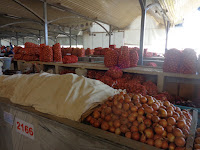In my previous post, I implied that Tashkent is a pretty dozy city, which is how I felt until I got my eyes opened by its markets, which are quite wakeful places. If you're just sleepwalking through orderly Oloy Bazaar -- whether it be the outdoor produce section (top left) or the indoor meat section (top right) -- vendors will break you out of your daze with shouts about free samples and good deals. The markets are definitely the community centers of the city where, as Mirabad Bazaar proved, nearly everything under the sun can be found (bottom).
Some markets are more animated than others. The decorations and delicacies in the grill section of the expansive Chorsu Bazaar were quite dizzying (top). Inside, the sheer volume of onions was equally overwhelming (bottom left). But nothing compared to the amount of fur and feathers to be found at the Saturday morning pet market (bottom right). I had to fight the crowd to find my way out without fish nor finch.
At a stall in Chorsu, we couldn't resist the smell of fresh somsa wafting out of their pottery pit ovens (left). TJ and I shared two types of Uzbekistan's version of a pasty: potato and meat. The somsa oven reminded me of the those used to cook naan in Pakistan. But the Uzbek bread called non is cooked in a structure more like a pizza oven (right).
Our somsa snack didn't fully satisfy us, so later, we headed over to the Central Asian Plov Center, where vats of the national dish are whipped up in woks heated by fires in stone cauldrons below (left). In the reception hall-style dining room, we ordered two dishes of plov, a rice dish that gets its name from the same etymology as pilaf, with a side of tomato-cucumber salad and green tea (right).
During a future lunch at Han Kuk Kwan, I had a second helping of tea. My teapot was only one of the many dishes placed on our table, which were full of small salads to accompany my bibimbap and TJ's bulgogi with rice (top). That spread was impressive, but by far, our best meal was dinner at Bagratione, a Georgian restaurant (bottom left). I definitely picked the better main dish, a traditional lamb stew called chanakhi, compared to TJ's stuffed pork chops, but he had the genius idea to order imeruli khachapuri, stuffed cheese bread (bottom right).
Lots of Tashkent establishments have themes based on countries, but many come off much less authentic. Although it served up reasonably priced and suitably tasty mugs of beer, Bier Regen lacked the oompah of a a true German beer garden (top left). The English pub atmosphere at Ye Olde Chelsea Arms was over the top, as were the prices of its beer (top right). But the least successful mix of expenses and environs was at Docker Pub, which seemed to be confused about how to saddle on a Western style; the overdone neon lights and tequila display made the empty dance floor seem extra sad (bottom).
I guess it's no surprise that we felt most welcome at the expat favorite Elvis Bar, which seemed like a comfortable college bar, especially because people were smoking inside (top). Another night, we got some fresh air over some Sarbasts, the Carlsberg brand produced in Uzbekistan, at a gazebo bar (bottom left). After it closed, we had one more beer and some pide at a bar that had a Turkish bent but not theme. The friendly waitress offered us some kurt, or fermented yogurt balls, to taste. I thought the salty-sour flavor went well with beer, like peanuts; in case you can't tell from the look on TJ's face, he did not concur (bottom right). Overall, my taste of Tashkent made me want more -- of the city, not kurt, that is.





















































